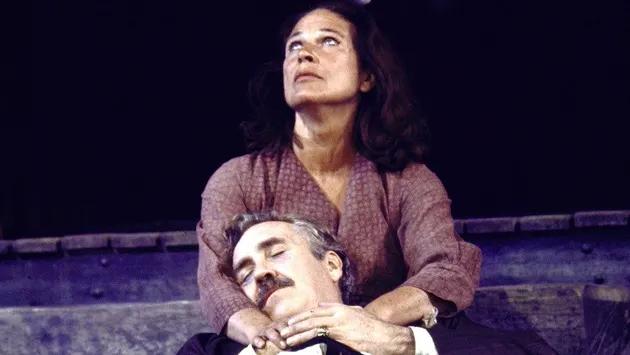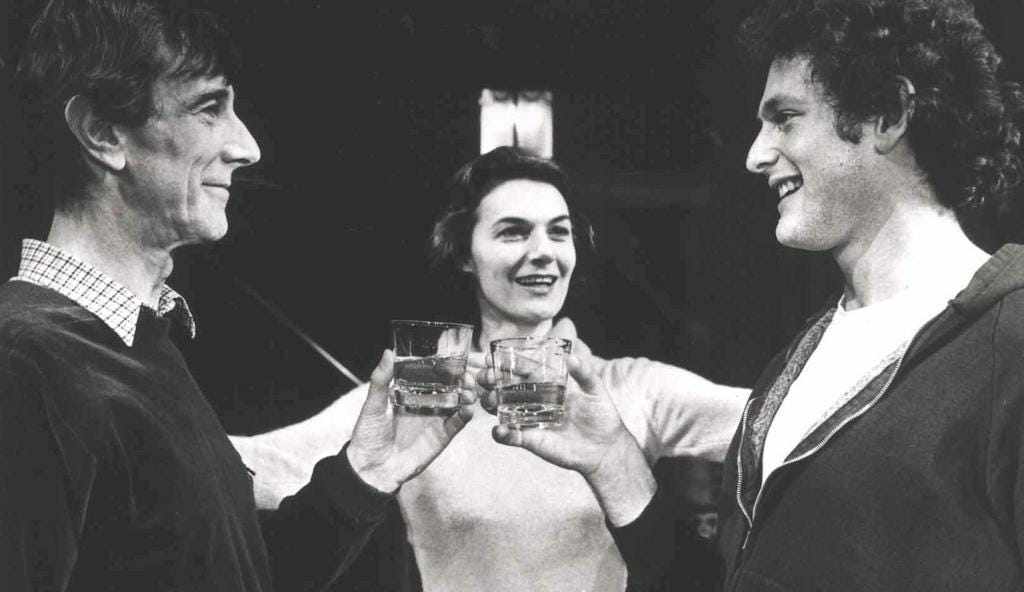
When it was announced in 1945 that Spencer Tracy was heading to the Broadway stage for the first time in fifteen years after great success as a film star in Hollywood, the news was greeted with tremendous excitement and anticipation for his return. What followed was not only disappointing for all concerned, but a story that could only be told many years after Tracy's death, such were the powerful ways of publicists to reframe and fictionalize what really went on. Thanks to author James Curtis's excellent research from his 2011 book Spencer Tracy: A Biography, among other sources, here are some glimpses behind the scenes of The Rugged Path that still tell a fascinating tale.
This following section from Curtis's biography perfectly encapsulates one of the chief problems at the core of the production of Robert E. Sherwood's The Rugged Path, which starred Spencer Tracy:
"Driven by an abhorrence of artifice and a natural terror of monotony, Tracy was constantly distilling the character to its essential elements, his stage effects coming wholly from within, all clean, sharp lines, lucid and completely free of the tricks 'some people pull on stage.' When a scene required him to emerge from the ocean after five days of being shipwrecked, he told [director Garson] Kanin he would not wear an appliance designed to simulate a growth of beard."
'It’ll look ridiculous,' Kanin argued. 'It’ll bother the audience.'
'No, it won’t,' countered Tracy.
'Why won’t it?'
'Because I’ll act unshaven.'"
That Tracy was demanding, arrogant and capable of pulling off such a stunt was well known. His naturalism was key to his depths as an actor and served him well as a major star of the Golden Age of Hollywood. By 1945, he was the only person to have won two Academy Awards as Best Actor (which he managed to do back-to-back in 1937 and 1938 for Captains Courageous and Boys Town). The envy of most actors in the film industry, his one-time co-star Hume Cronyn said of Tracy that "his method appeared to be as simple as it is difficult to achieve. He appeared to do nothing. He listened, he felt, he said the words without forcing anything." Stanley Kramer, who directed him in four films, felt "he thought and listened better than anyone in the history of motion pictures." And the great James Cagney, himself widely imitated, said of Tracy "you can't mimic reserve and control very well... there's nothing to imitate except his genius and that can't be mimicked."
Prior to his Hollywood success, Tracy was a total stage animal, trained in the theatre with years of regional performances under his belt before Broadway beckoned. His debut was A Royal Fandango in 1923, which starred Ethel Barrymore and featured another up and comer, Edward G. Robinson. But like his next four shows, Fandango folded quickly, leaving Tracy to scramble for other employment. It wasn't until February of 1930, when he starred as Killer Mears in a prison drama called The Last Mile that Tracy got the recognition that made the motion picture industry take notice. He received a 2-week leave of absence from The Last Mile to star in Up the River, also a prison drama, shot in New York City, which featured another young Broadway actor, Humphrey Bogart. The two would remain lifelong friends until Bogart's death in 1957.

That Spencer Tracy had a drinking problem was well-known, though stories of just how exceptionally bad it was never reached gossip magazines (such was the power of a major film studio like MGM's mammoth publicity department). But among producers, directors and fellow actors, it was an open secret. Not only would Tracy get drunk, but he would disappear for weeks at a time. No one knew what state he was in both figuratively and literally, as he would sometimes go back to his hometown of Milwaukee where there were simply too many bars to find him. When he would be found, he would have to be institutionalized under fake names. Sometimes things were so horrible, and his delusions so severe, he would be put in a strait jacket under the supervision of doctors, who administered drugs like Sodium Luminal, used medicinally as a sedative, hypnotic, and anticonvulsant.
It was after one such stay in 1945 that Tracy was nursed back to good health and ready for his next project. Katharine Hepburn, who he began a relationship with after they co-starred together in 1942's Woman of the Year, always went back and forth between screen and stage and encouraged him to return to the discipline it required, thinking it would be good for him. When a property came to his attention by renowned playwright Robert E. Sherwood, someone whom Tracy greatly admired, it seemed like it might be a good vehicle to summon him back on the boards. Sherwood had a number of hit shows that went back to the 1920s and was the recipient of three Pulitzers for drama—one for each of his previous three plays.

Engaged as director was young Garson Kanin, who was something of a wunderkind, having directed his first feature film at twenty-six, starring the legendary John Barrymore. Out of town tryouts were scheduled for Rhode Island, Boston and Washington, D.C. before an opening in November at the Plymouth Theatre (the same theatre where Tracy had debuted in A Royal Fandango). An escape clause was inserted into Tracy's contract, giving him an out during the first three weeks of performances and another during the New York run of the play. As Curtis writes, "He had full confidence in Sherwood’s work; it was the lead actor who gave him pause. Could he still manage the sustained concentration he’d need to carry a play? Could he achieve the same level of purity he had learned to put forth on film?"
When rehearsals began in September of 1945, he sent a telegram to his son John. It read: EVERYTHING WENT WELL EXCEPT I AM SCARED.
The announcement of Tracy's appearing in a new wartime drama during what would prove to be the waning days of WWII, and written by such an esteemed name as Sherwood's, proved a box office bonanza. After rehearsing in New York on the stage of the 1,000 seat Plymouth Theatre, the move to Providence's Metropolitan — a 3,000 seat house — was disconcerting, to say the least. But Tracy handled its demands beautifully and the engagement easily sold out for its first performance, such was the excitement for Tracy's return to the stage. His character, Morey Vinion, was a career journalist interfacing with soldiers at war. He was in strong command of a company of thirty-seven actors, including himself. It was daunting, but critics proved to be impressed with Tracy... though not with the play.
The reviews made it clear there was much work to be done. The critics in Boston were equally unimpressed, making Tracy's already shaky confidence erode further. But according to Curtis, he didn't seek solace in the bottle, as Tracy assuredly knew it could mean the end of his career. He would be letting down dozens of people whose employment he held in his hands by risking even a single drink. And considering he was under heavy scrutiny by both Broadway and Hollywood, he resisted the temptation.
Tracy began to bristle at Kanin's direction and changes Sherwood was making in the script, digging in his heels at their suggestions. Things really started breaking down prior in Boston, exacerbated by the generally poor reviews for the play. Though the show continued to do fine business, the actor was unhappy doing eight performances a week in a play that was not leaving audiences the better for their sitting through it. He immediately sought advice on the best way of getting out of it, even before heading for D.C. and Broadway.

No one tried harder to keep the star on board than playwright Sherwood. Built for Tracy, there was no way it could run without him. In fact, when the New York Times reported that Tracy was considering leaving the show prior to its Broadway opening, it caused its advance sale in New York to plummet. Even with tepid reviews, the show was still selling out due to Tracy's appeal and Sherwood had to beg the actor to stay if only for the magic number of 100 performances, which he hoped might yield a Hollywood film sale. But once it opened in New York to lackluster reviews, Tracy grew more and more bitter. He hated the grind, hated the play, even hated his fellow actors. He took to giving notes (verboten for any actor to do) and would not speak to anyone except on stage.
The Rugged Path closed after eighty-one performances and Tracy would never return to the stage. Funnily enough, the following year was mighty good for both Garson Kanin and Robert E. Sherwood. Kanin had a smash hit with Born Yesterday, which he wrote and directed and is still one of the longest-running non-musicals of all time. And Sherwood's adaptation of MacKinlay Kantor's novel Glory for Me, retitled The Best Years of Our Lives, won him an Academy Award for his screenplay as well as the Best Picture of 1946.
The Rugged Path, however, remains a blip on the radar screen of the illustrious careers of Kanin, Sherwood and Tracy.
If you enjoy these columns, check out Up in the Cheap Seats: A Historical Memoir of Broadway, available at Amazon.com in hardcover, softcover and e-book. And please feel free to email me with comments or questions at Ron@ronfassler.org.





















Write a comment ...